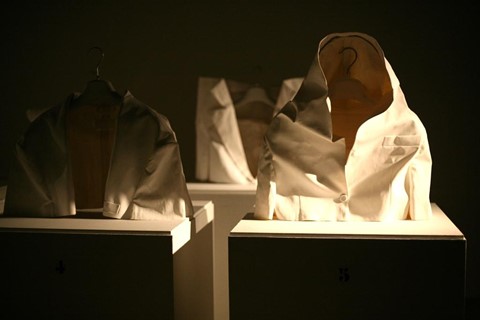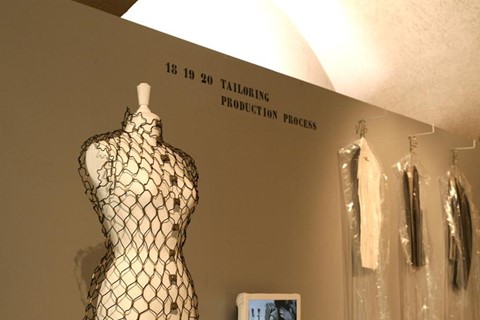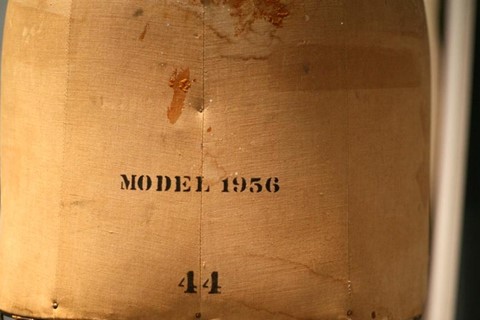After its debut in Antwerp at the MoMU Fashion Museum, and a second showing in Munich, the Maison Martin Margiela ‘20’ Exhibition, celebrating the label’s 20th anniversary, opens at Somerset House in London. Eagerly anticipated, the show presents

After its debut in Antwerp at the MoMU Fashion Museum, and a second showing in Munich, the Maison Martin Margiela ‘20’ Exhibition, celebrating the label’s 20th anniversary, opens at Somerset House in London. Eagerly anticipated, the show presents some of the most forward-thinking and avant-garde artisan pieces alongside catwalk videos, installations, jewellery and three fantastic films showing the wardrobes – and numerous styled looks – of three dedicated Margiela collectors. Pulling together the three main figures behind the curation, organisation and aesthetic of the exhibition, we asked Kaat Debo (curator of exhibitions at MoMU), Bob Verhelst (exhibition designer and scenographer for Maison Martin Margiela), and Claire Catterall (curator at Somerset House) about the show, and what makes MMM quite so special.
How did you come to work for Margiela?
Bob Verhelst: I studied with Martin and kept in contact. I had always been interested in what he was doing, and at the first Maison show asked him if he needed any help, and have now been working with the label for eight years.
Kaat Debo: I don’t work for the Maison, but I have worked a lot with Bob. I started to work with him on our very first exhibition for the opening of MoMU and we have done almost all our exhibitions together since. We realised that 2008 was going to be the 20th Anniversary of Margiela, so I said, “Bob, maybe you could call Martin?”
Claire Catterall: So Bob is actually proof that Martin exists!
KD: For us it was important that someone who knew the language of the house was involved. It had to not be about simply painting everything white and saying “this is Margiela.” During the research period we started to ask, “What are the codes and the language of the Maison?” And since Bob has been so involved he was the ideal person to answer.
BV: One of the inherent languages of the Maison is the use of the trompe l'oeils, and I quickly realised how important that was. We wanted to carry that through the exhibition, but didn’t want to re-use their photographs as it would simply turn the gallery into a Margiela store. We wanted to incorporate the concept but give it new meaning, which is why we made new trompe l'oeil for each show, taken from the walls of the different museum buildings.
Will Martin see the show?
BV: Ah, well I know he saw the show in Antwerp and he also dropped by to Munich, so it is a possibility.
KD: He doesn’t let you know though, he will just turn up. I guess it depends if he wants a weekend in London!
What makes the London show unique to the others?
CC: I think some of the rhythms are different to how it appeared in Antwerp or Munich, because the team has had to work with the quite difficult shape and space of the gallery at Somerset House.
KD: One of the things I have noticed here is how forthcoming the “shoulders” section is, which is great because the form of the shoulder in Margiela pieces is in a way key to what he does. He started designing at the end of the 80s when it was about big powerful shoulders, and he did the complete opposite keeping it super narrow and refined. Then recently in the collections it was back to the large pronounced shoulder, and although this is now common through houses like Balenciaga and Balmain, at the time it was all about the minimal aesthetic so was quite a contrast. He has basically reversed the common silhouette, 20 years apart.
Is the show a retrospective of the Margiela archive, or are you trying to do something further than simply display those pieces?
KD: It is about more than just the collections, it is about the brand, the stores and how they sell their fashion.
BV: The exhibition is about identifying the whole language of Margiela.
What is it about Margiela that you think has such appeal? Although an avant-garde label it is worn and admired widely.
KD: It is true – if you go to a party of architects, artists, fashion people, designers, you can see the four little white stitches everywhere. I think there are two houses where this is the case though: Comme des Garçons and Maison Martin Margiela.
Yes true, but I actually think – and I may get into trouble for saying this – Margiela is more respected because in a way Comme now has a sense of diffusion to it.
KD: Ah, maybe it’s true. I think Margiela is one of the only brands that don’t sign the label, but in a way have created the idea of the hyper label. You can see those four white stitches when someone is wearing the garment, but it still has a level of anonymity, it is not brazen. I think that is something that creates a level of elitism and appeal, but quietly.
BV: Also, he builds his collections up over many years, so that you can pull pieces out of the archive from two or ten years ago and wear them with pieces from the current collection. He is really an incredibly good tailor.
CC: He is just so good at making the “perfect piece.”
KD: Martin makes some incredibly interesting pieces, but he can also make a really great simple jacket. Not all designers have the ability to do that. You can only make great conceptual pieces when you have a strong understanding of the history of fashion. You have to know how to construct a piece of clothing before you can deconstruct it.
BV: With Margiela, when you put something of his on you not only look a certain way and make an impact, but you also feel completely comfortable because the cut, the line and the quality is so perfect.
KD: Some of the ideas are really extreme but the idea never overpowers the garment. The garment itself is still elegant and that really is the essence of Margiela.
Rosey Trickett is a freelance photographer based in London






